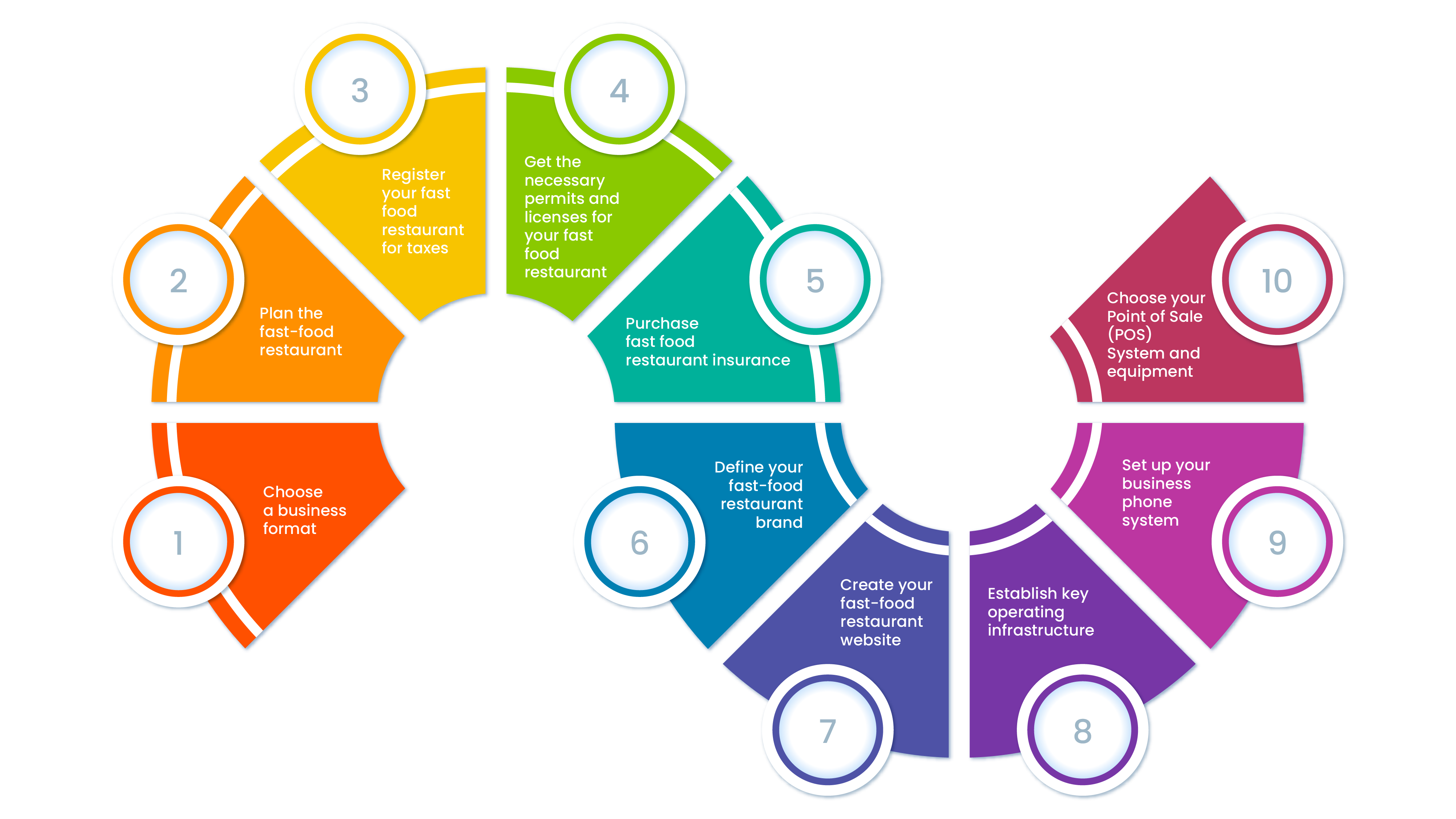- Email:support@posbytz.com
08 Dec

Checking the industry’s growth rate of approximately 19% per year, you may now be eager to know how to start from scratch. Here is the step-by-step guide:
How to Start a Fast Food Restaurant – Step By Step Guide

1. Choose a business format
First and foremost, you need to choose the right business structure that gives you the right balance of legal protections and benefits. Will you run it as a sole proprietorship or partnership? Will it be a franchise, a corporation, or a limited liability company? Depending on these answers, tax consequences and required legalities will be defined.
2. Plan the fast-food restaurant
You have to start with an excellent fast-food restaurant business plan. To come up with an effective business plan, you have to consider a few things, such as:
Cost of opening a fast-food restaurant
Opening a fast-food franchise in the US can cost you anywhere, starting from $10000 and even far more, as the estimation depends on lots of aspects. You may need to budget for expenses such as cooking equipment, monthly rent, laborers, marketing, insurance, and utilities.
Consideration of the best place to open a fast-food restaurant could affect the overall budget as monthly rent and the price of cooking ingredients differ from place to place.
Choose the best name for your business
Choosing the right name for a business is a challenge. Consider these things while brainstorming for names:
- The naming rules for your business structure
- If you already have a name in mind, check to see if it’s available.
- Federal and state trademark records
- Web domain availability
- Social media platforms
Target Audience
Budget is the request that will define your journey, but the audience will define your luck in business. However, you have a significant role in making your luck the best it can be for doing business in the chosen location. Look kids, teenagers, and young adults are your target customers, so you have to come up with marketing strategies that will appeal to them.
Set your pricing strategy
The target consumers will likely have less money for fast-food restaurant businesses in the US or elsewhere, but they are enough to attract parents. So, you can set the price for each item by considering the commodity price and price rise and comparing the competitor’s price. You can keep your pricing lower than others in your area to gain a competitive advantage.
For instance, suppose your restaurant is near a college or university. Following that, you will be targeting students who will most likely earn low wages from internships and private tuition or manage expenses with their pocket money. Thereby, only a low price with uncompromising quality could make your brand most desirable to them.
Form your fast-food restaurant into a legal entity
When you create a legal business entity for your company, you protect yourself from being held personally liable if your fast-food restaurant is accused of anything. You should choose a legal entity by considering the ease of starting and maintaining a business and how tax rules affect your finances, growth, and chance of partnering.
3. Register your fast-food restaurant for taxes
How your business will be taxed will depend on your business structure. Before that, you must apply for an EIN (Employer Identification Number) to register your business with the federal government.
Understand your finances and operating expenses
Open a business bank account and credit card
You’ll need to showcase a business bank account when you apply for business loans. It also protects your personal assets by separating them from your company’s assets and easing the accounting and tax filing processes. Having a business credit card will add another advantage by putting all business expenses in one place.
Set up accounts for your fast-food restaurant
Keeping track of various expenses and income from multiple sources to analyze financial performance is a challenging task. A reliable POS system can help you easily maintain an accurate and detailed account, analyze growth or loss rates, handle annual taxation, and all other account-related chores.
4. Get the necessary permits and licenses for your fast-food restaurant
Here, you need to know what kind of business a fast-food restaurant is. Following that, you can conduct in-depth research on required licensure and legalities. However, when it comes to serving food, lots of permissions and licenses from a range of authorities are required. You’ll need to acquire the following permits to avoid hefty fines or protect your business from being shut down:
A federal business license from the Food and Drug Administration regarding what can and cannot be sold
State permits and licenses regarding sales tax for local businesses
Certificate of Occupancy to confirm that all zoning laws, government regulations, and building preventive measures have been met.
Food regulations from the local health department
5. Purchase fast food restaurant insurance
Different types of businesses have different risks, and various business insurance policies are also available based on associated risk factors. Having general liability insurance and worker’s compensation insurance is enough to protect the financial well-being of a small start-up business.
6. Define your fast-food restaurant brand
A strong brand promotion through a wide variety of local channels, like advertisements on billboards, in local newspapers, on the radio, and TV, will help you promote your fast-food restaurant beyond your target audience. Before that, you must create a unique, remarkable brand name and logo that will be easy to remember and relate to your services.
7. Create your fast-food restaurant website
The need for physical distance during the pandemic period increases the proclivity to order food online. So, you have to come up with your own online food ordering service with a website and be available on online food delivery apps like Zomato, Swiggy, etc. You can integrate a POS food ordering system and delivery system into your website to handle all online orders efficiently and with ease.
8. Establish key operating infrastructure
Working with a restaurant POS system eases the workflow of everything, from inventory management to table management, from handling staff to online, takeaway, and dine-in orders, to the accounts and taxation of a small outlet to a multi-chain outlet.
9. Set up your business phone system
When you start offering online food services, the rate at which you get phone calls will be high. People will call the outlet numbers to follow up on their orders. Having a business phone system helps deliver excellent customer service and reduces work pressure on you and other staff by separating personal and professional calls.
10. Choose your Point of Sale (POS) System and equipment
Figuring out the best equipment, phone system, and POS system is up to your budget and business needs. Figure out the best for your business by considering employee count, customer base, outlet locations, and budget. Posbytz is your all-in-one restaurant POS system where you can smoothly manage all your operations, from purchasing multi-channel sales and reports in one dashboard.
Conclusion
Running a fast-food restaurant can be challenging and highly rewarding. Who doesn’t want to excel in business? But, when it comes to facing the challenge, only a few people stick to their decision to start a business. Congratulations on trusting your intuition! Now is the time to put your gut instinct into action.
Make your business idea rock with one of the best POS restaurant software programs, Posbytz. Check out more about the various offerings to run your business successfully without facing any hassle.
Related Resources
Recent Posts
- Payroll Software 101: Everything You Need to Know
- Choosing the Best CRM for Restaurants: A Comprehensive Guide
- “Why Every Restaurant Needs CRM Software for Enhanced Customer Engagement”
- Affordable and Efficient: Best Payroll Software for Small Businesses
- Payroll Solutions for Small Businesses: Features, Benefits, and Recommendations
PosBytz is a ERP software for Restaurant and Retail business on cloud with POS, Online ordering, Inventory, Accounting, CRM , Payroll and many more
PosBytz is a product of Inovo Holdings Ltd

